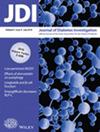Urinary fatty acid-binding protein 4 is a promising biomarker for glomerular damage in patients with diabetes mellitus
Abstract
Aims/Introduction
Fatty acid-binding protein (FABP) 4, which acts as an adipokine secreted by adipocytes, macrophages, and capillary endothelial cells, is expressed in injured glomerular cells. It has been reported that urinary (U-) FABP4 is associated with renal dysfunction and proteinuria in several glomerular kidney diseases. However, the clinical significance of U-FABP4 in diabetic kidney disease (DKD) remains undetermined.
Materials and Methods
Immunohistological analyses of FABP4 and FABP1 (liver-type FABP), an established biomarker for impaired proximal tubules, were performed in the kidneys of patients with DKD and nonobese diabetic mice (KK-Ta/Akita mice). The associations between U-FABP4 and U-FABP1 with kidney function and metabolic indices were also investigated in patients with type 1 diabetes (n = 57, mean age: 61 years) and patients with type 2 diabetes (n = 608, mean age: 65 years).
Results
In both patients with diabetes and diabetic mice, FABP4 was expressed in injured glomeruli with increased markers of endoplasmic reticulum stress in addition to peritubular capillaries, whereas FABP1 was mainly expressed in proximal tubules. Levels of U-FABP4 and U-FABP1 were independently associated with each other, and both levels were independently associated with estimated glomerular filtration rate (eGFR) and urinary albumin-to-creatinine ratio (UACR) after adjustment of age, sex, type of diabetes, duration of diabetes, and systolic blood pressure in patients with diabetes.
Conclusions
Urinary level of FABP4 derived from injured glomeruli with increased endoplasmic reticulum stress is independently associated with eGFR and UACR, suggesting a promising biomarker for glomerular damage in patients with diabetes.

 求助内容:
求助内容: 应助结果提醒方式:
应助结果提醒方式:


